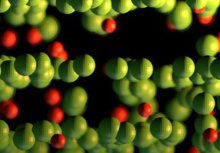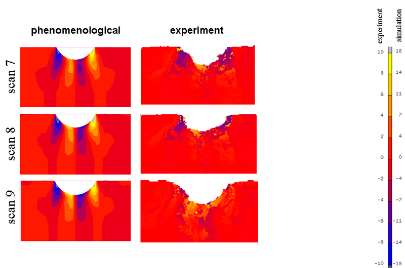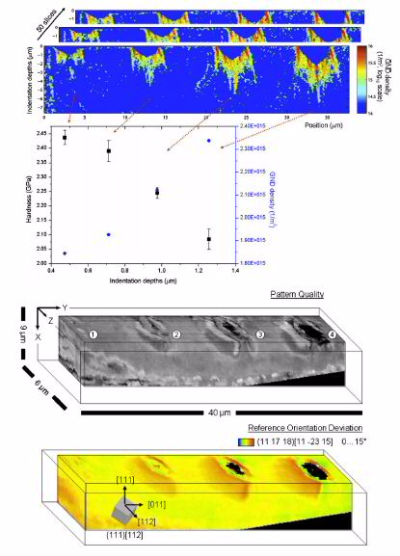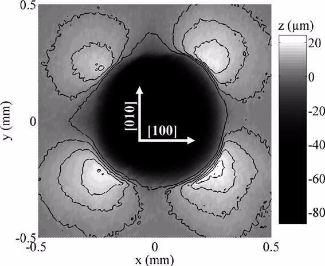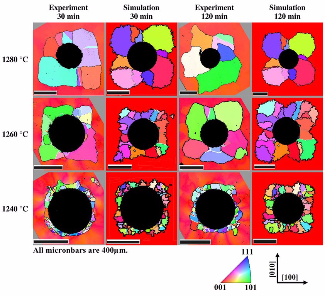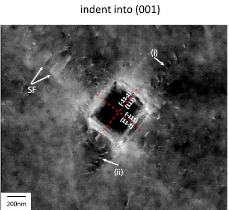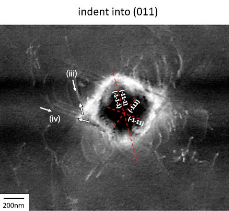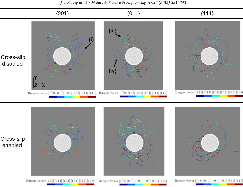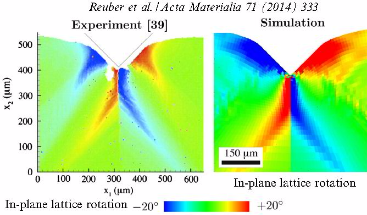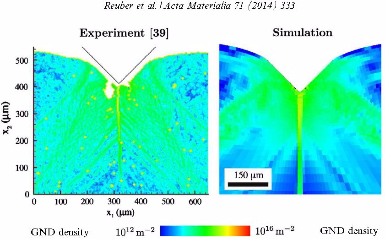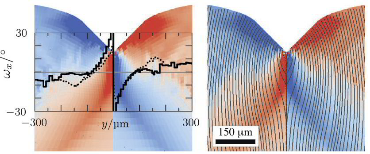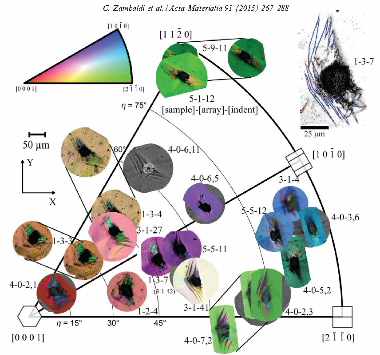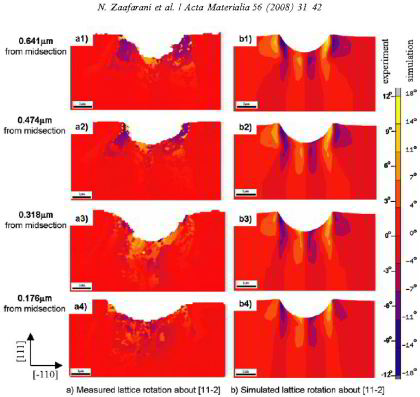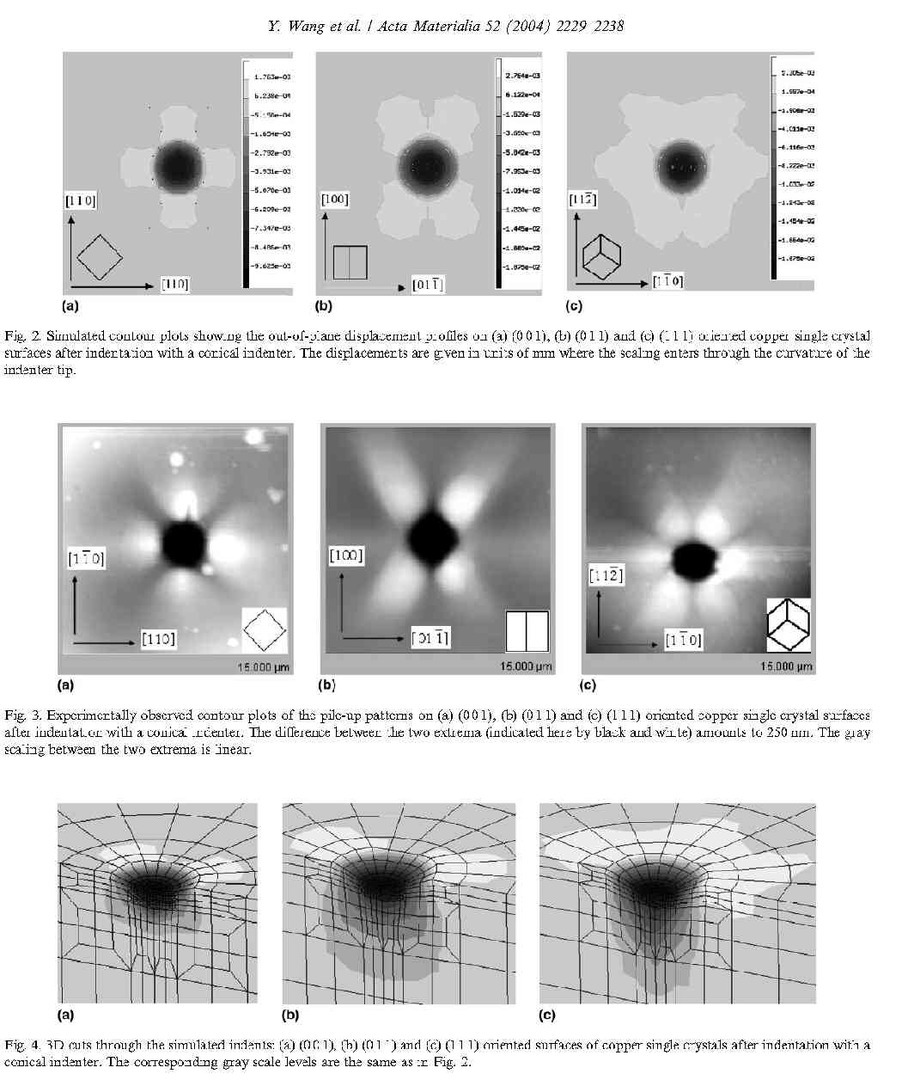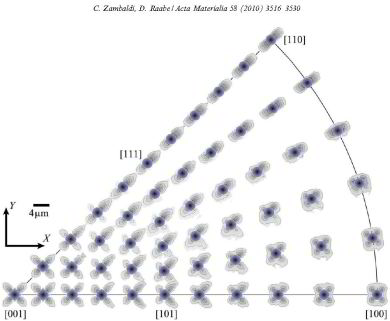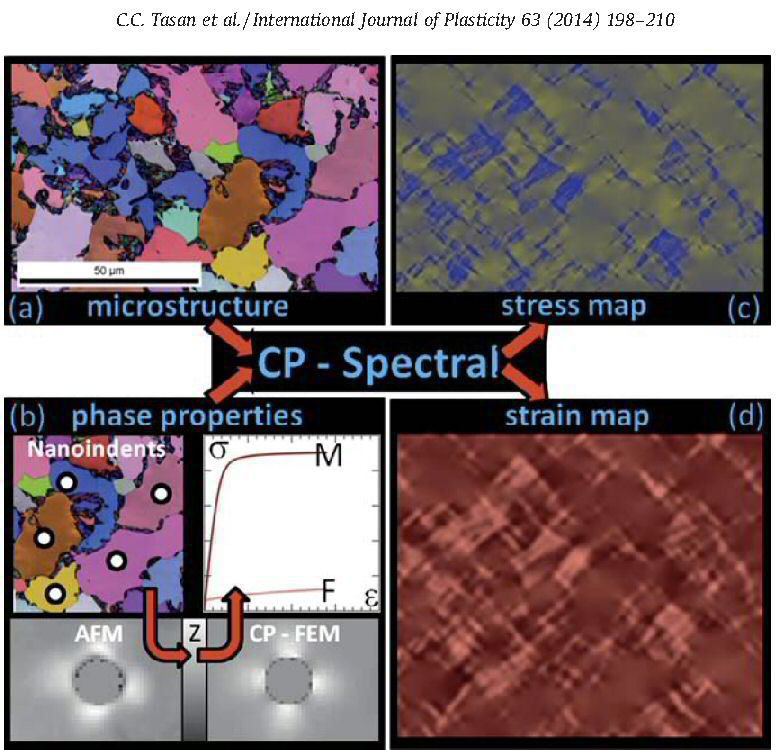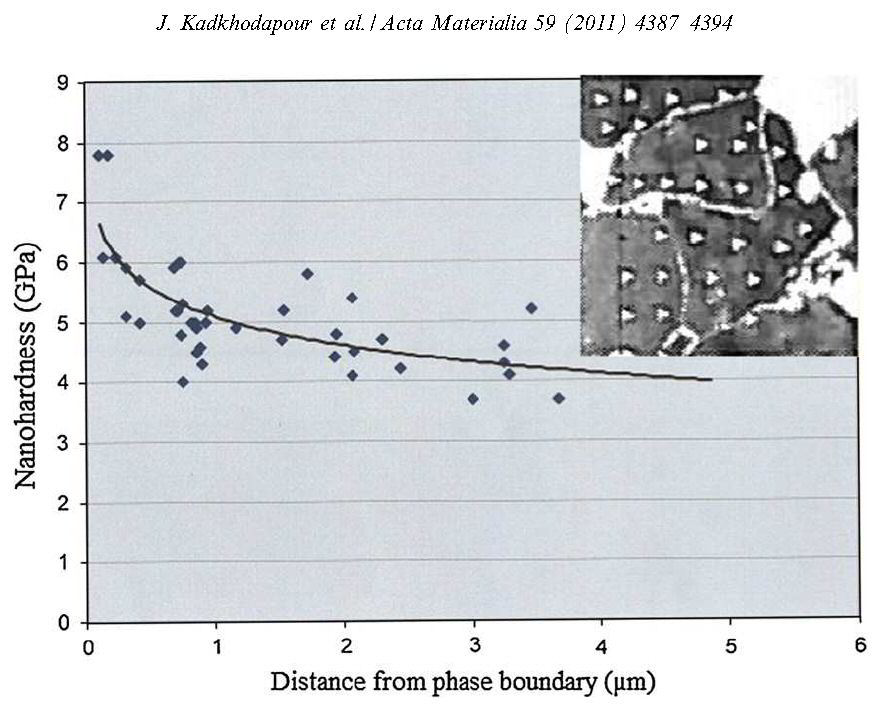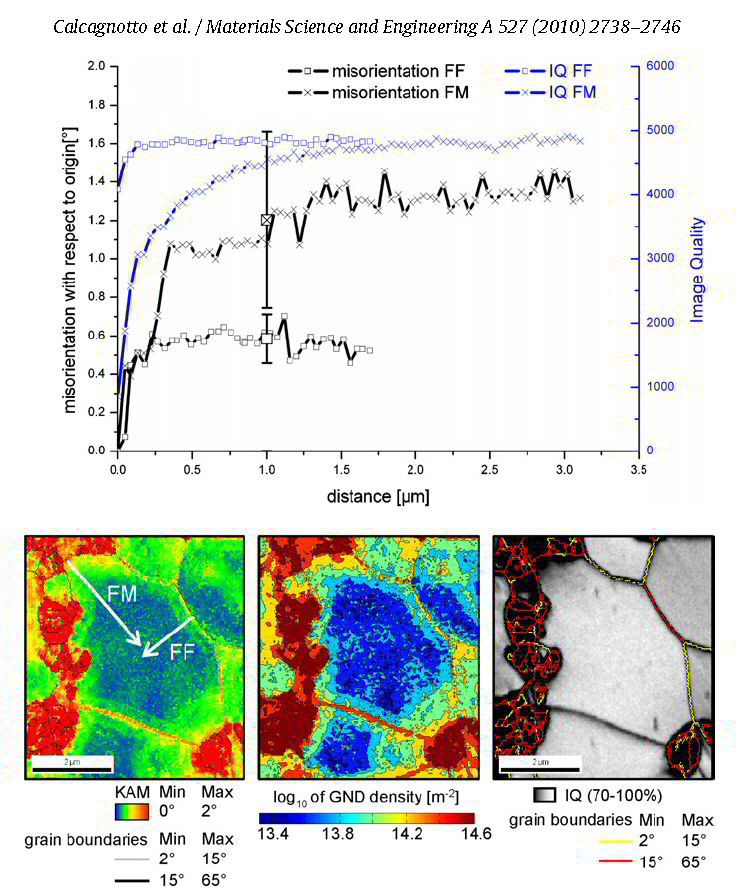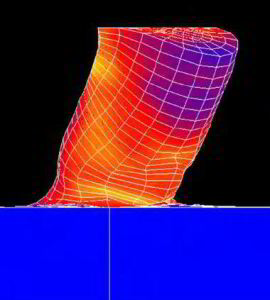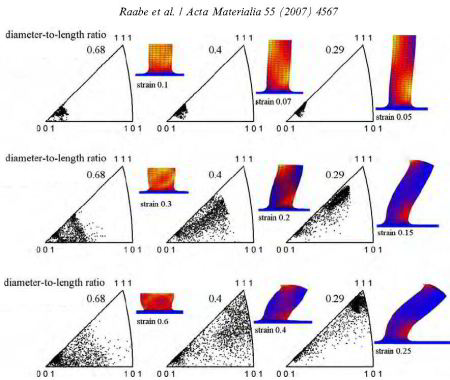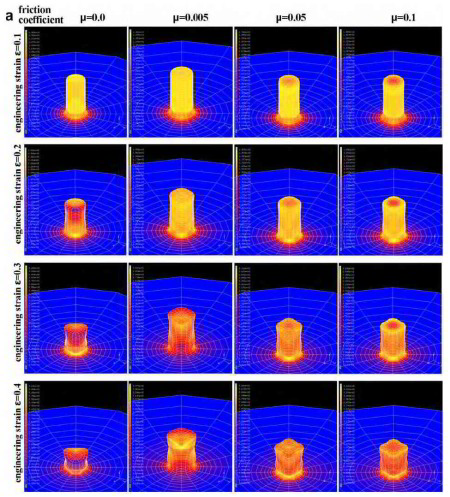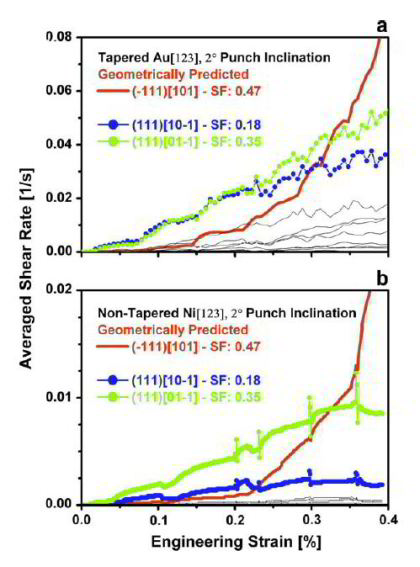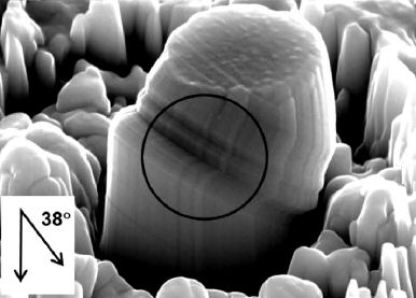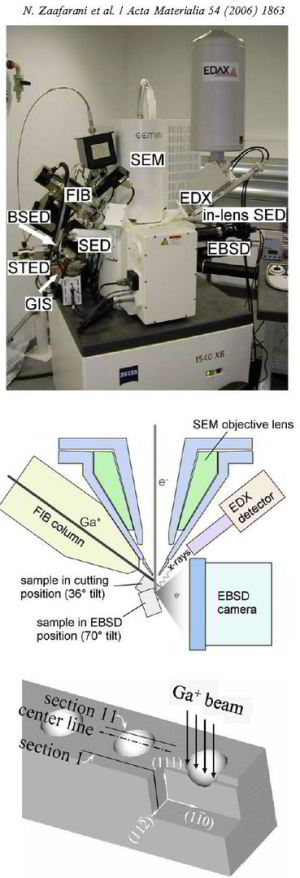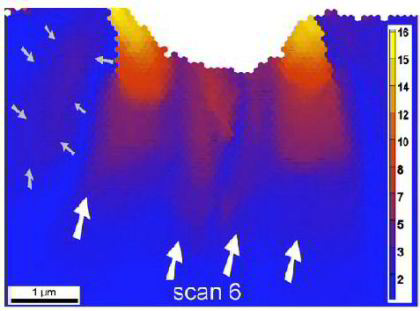Simulation of Nanoindentation, Indentation and Pillar Compression
Crystal Plasticity Finite Element Modeling Indentation
We are interested in a better understanding of the deformation zone around nanoindents and indents. This knowledge is of considerable importance for nanoindentation testing because the shape of the out-of-plane displacement zone determines the actual contact area between the indenter and the specimen. Sink-in patterns reduce and pile-up patterns increase the contact area. These differences in the surface deformation mode affect the quantitative analysis of the hardness measurements. Not taking the piling-up or sinking-in into account in micro- and nanoindentation hardness tests can result in errors when extracting hardness or related micromechanical measures from the experimental data. Our investigations are therefore concerned with the anisotropy of the surface profiles around and below nanoindents and their crystallographic interpretation in terms of the active slip systems and local texture changes. Our approach to this issue consists in a combination of indentation testing, high-resolution texture measurements, and nanoindentation simulations. For the experiments we use single crystalline copper specimens with different orientations. The indentation tests are conducted with a Hysitron TriboIndenter setup using a conical indenter in order to avoid symmetries others than those of the crystal structure. Texture measurements are performed using a high resolution electron back-scatter diffraction (EBSD) technique for the automated acquisition of texture mappings around the indents. The experimentally observed nanoindentation pile-up patterns and textures are compared to corresponding predictions obtained by a 3D crystal plasticity finite element simulation method which takes full account of crystallographic slip and orientation changes during indentation.
What is the relationship between nano- and microindentation and the density of geometrically necessary dislocations?
We have studied the link between the indentation size effect and the density of geometrically necessary dislocations (GNDs) through the following approach: four indents of different depth and hardness were placed in a Cu single crystal using a conical indenter with a spherical tip. The deformation-induced lattice rotations below the indents were monitored via a three-dimensional electron backscattering diffraction method (3D EBSD, EBSD tomography) with a step size of 50 nm. From these data we calculated the first-order gradients of strain and the GND densities below the indents. This approach allowed us to quantify both the mechanical parameters (depth, hardness) and the lattice defects (GNDs) that are believed to be
responsible for the indentation size effect.Wefind that theGNDdensity does not increase with decreasing indentation depth but rather drops instead. More precisely, while the hardness increases from 2.08 GPa for the largest indent (1230 nm depth) to 2.45 GPa for the smallest one (460 nm depth) the GND density decreases from 2.34x10^15 / m^2 (largest indent) to 1.85X10^15/ m^2 (smallest indent).
Acta Materialia 57 (2009) 559-569
Investigation of the indentation size effect through the measurement of the geometrically necessary dislocations beneath small indents of different depths using EBSD tomography
E. Demir, D. Raabe, N. Zaafarani, S. Zaefferer
Acta Mater 57 (2009) 559 Investigation o[...]
PDF-Dokument [1.9 MB]
Can we study recrystallization with indentation tests and simulation?
In this project an integrated simulation strategy for the characterization of primary recrystallization was developed and applied to a second generation single-crystal nickel-base superalloy. By using a crystal plasticity finite element approach, the driving force for nucleation and grain growth around a Brinell-type indent was modeled. The crystal-plasticity approach was validated by comparison to the experimentally observed pile-up behavior and the load-displacement curve obtained from the indentation test. The crystal plasticity material parameters were fitted to uniaxial compression data of a corresponding single-crystal. Good agreement between experiment and simulation was obtained for the anisotropic pile-up pattern. A subsequent annealing process, leading to the formation of newgrains via primary recrystallization,was simulated by using a cellular automaton that employed a continuous nucleation model. This simulation was not only reflecting the kinetics of primary recrystallization, but it was also capable to match the experimentally observed recrystallization microstructures.
More specific this study presents crystal-plasticity finite-element calculations of room temperature deformation of a single-crystal nickel-base superalloy and simulation results on the microstructural development during subsequent recrystallization. The predictions are compared to corresponding experiments. Single-crystalline material is deformed by Brinell-type indentation using a spherical indenter of 1mm in diameter. A succeeding annealing under inert atmosphere leads to the formation of recrystallized grains around the indents. The crystal plasticity finite element method is used to predict the distribution of crystallographic slip around the indents. The amount of accumulated slip is used to estimate the stored deformation energy in the indented volume. A 2D probabilistic cellular automaton simulation is then applied to the predicted distribution of the stored energy for the simulation of the formation and growth of new grains around the indents. The cellular automaton predicts the kinetics, microstructures, and crystallographic texture evolving during recrystallization.
Materials Science and Engineering A 454–455 (2007) 433-440
Modeling and experiments on the indentation deformation and recrystallization of a single-crystal nickel-base superalloy
C. Zambaldi, F. Roters, D. Raabe, U. Glatzel
Materials Science and Engineering A 454–[...]
PDF-Dokument [483.7 KB]
What is the orientation-dependence of nanoindentation in Titanium?
We studied the anisotropic indentation response of alpha-titanium. First, coarse-grained titanium was characterized by electron backscatter diffraction. Sphero-conical nanoindentation was performed for a number of different crystallographic orientations. The grain size was much larger than the size of the indents to ensure quasi-single-crystal indentation. The hexagonal c-axis was determined to be the hardest direction. Surface topographies of several indents were measured by atomic force microscopy. Analysis of the indent surfaces, following Zambaldi and Raabe (Acta Mater. 58(9), 3516–3530), revealed the orientation-dependent pileup behavior of alpha-titanium during axisymmetric indentation. Corresponding crystal plasticity finite element (CPFE) simulations predicted the dislocation pile-up patterns with good accuracy. The constitutive parameters of the CPFE model were identified by a nonlinear optimization procedure, and reproducibly converged toward easy activation of prismatic glide systems. The calculated critical resolved shear stresses were 150 +/- 4, 349 +/- 10, and 1107 +/- 39 MPa for prismatic and basal〈a〉-glide and pyramidal〈c + a〉-glide, respectively.
J. Mater. Res., Vol. 27, No. 1, Jan 14, 2012
Orientation informed nanoindentation of [...]
PDF-Dokument [373.1 KB]
Dislocation patterns below indents studied by electron channeling contrast imaging and discrete dislocation dynamics simulations
Electron channeling contrast imaging under controlled diffraction conditions (cECCI) enables observation of crystal defects, especially dislocations, stacking faults and nano-twins, close to the surface of bulk samples. In this work cECCI has been employed to observe defects around nanoindents into the surface
of {100}-, {110}-, {111}-oriented grains in a Fe–22Mn–0.65C (wt%) TWIP steel sample (fcc crystal structure, stacking fault energy 20 mJ/m²) using a cone-spherical indenter. The dislocation patterns show four- and two-fold symmetries for the {100}- and {110}-orientation, and a three-fold symmetry for the {111}-orientation which is, however, difficult to observe. Discrete dislocation dynamics (DDD) simulations of the indentation were carried out to complement the static experimental investigations. The simulations were carried out with both, cross-slip disabled and enabled conditions, where the former were found to match to the experimental results better, as may be expected for an fcc material with low stacking fault energy. The 3-dimensional geometry of the dislocation patterns of the different indents was analysed and discussed with respect to pattern formation mechanisms. The force-displacement curves obtained during indentation showed a stronger strain hardening for the {111} oriented crystal than that for the other orientations. This is in contrast to the behaviour of, for example, copper and is interpreted to be due to planar slip. Irrespective of orientation and indentation depth the radius of the plastically deformed area was found to be approximately 4 times larger than that of the indenter contact area.
Materials Science & Engineering A 636 (2015) 231-242
A study on the geometry of dislocation patterns in the surrounding of nanoindents in a TWIP steel using electron channeling contrast imaging and discrete dislocation dynamics simulations
J.-l. Zhang, S. Zaefferer, D. Raabe
Materials Science Engin A636 (2015) 231 [...]
PDF-Dokument [1.5 MB]
Why do we study indentation by Crystal Plasticity Finite Element Simulations and how do we consider Geometrically Necessary Dislocations?
The indentation of metals is widely used for material characterization and the derivation of mechanical properties. Although the actual deformation process is simple, the boundary conditions and kinematics involved are complex. Accordingly, structure formation below indents is complex too, rendering the derivation of the corresponding structure–property relationship challenging. Hence, a thorough understanding of the underlying substructure evolution associated with indentation is of great importance. One reason for the complexity of the deformation state is its strong variation both in space and time. Since the load of the indenter is locally applied, high gradients in the stress, strain and rotation fields naturally arise. As demonstrated by using 2-D and 3-D electron backscatter diffraction (EBSD) methods for a sphero-conical indenter, the loading of the material under the indenter changes with increasing indentation depth and induces a rapid change in the activated slip systems in space and time.
Variations in the plastic deformation also lead to a heterogeneous distribution of dislocations: regions of high plastic slip activity naturally contain more dislocations than weakly deformed regions. This relation between slip and the statistically stored dislocation (SSD) density can be described well by a local dislocation-based constitutive model. If all dislocation loops are statistically equally distributed within and among the slip systems, then on average the signed character of the single dislocation segments mutually compensate and the ensemble of dislocations is neutral in the sense that no net Burgers vector (or plastic incompatibility) arises. A gradient in plastic slip, however, gives rise to an imbalance of dislocation segments of positive and negative sign, thus building up an excess of signed dislocations, also referred to as geometrically necessary dislocation (GND) density. It is these GNDs that accommodate gradients in the lattice rotation field. However, they cannot confidently be predicted by a local constitutive law, since their origin—namely the redistribution of dislocations—is inherently nonlocal. A new simulation approach has emerged in recent years; the so called continuum density-based dislocation dynamics (CDDD) models, which treat dislocations as continuously defined dislocation density that evolves in time but also proceeds in space. While similar in spirit, they differ in the degree of detail for the description of the dislocation density. Avery detailed description is achieved when dislocations are represented by a higher-order dislocation density tensor that retains information about the line direction and the curvature. With this description it is possible to formulate evolution laws for the dislocation density based only on the motion and balance equations of dislocations. When supplemented by a kinetic law, this formulation captures the kinematics of crystal plasticity in fine detail. In order to reduce the substantial computational effort associated with such approaches, various simplifications were suggested to reduce this large configuration space: the restriction to two excess densities of edge and screw character plus their mean curvature and the total dislocation content, a single, but spatially variable line direction plus its mean curvature, the use of four density measures of straight edge and screw dislocations of opposite signs, or one excess density and the total dislocation density when restricting the model to two dimensions. In our current approach, we develop a model that includes dislocation transport. We apply this model to an existing microindentation experiment in single-crystalline Ni that was performed by Kysar. This experimental reference is chosen since the deformed volume in the experiment is, on the one hand, large enough so that statistical effects such as dislocation source sampling can be neglected; on the other hand, it is small enough so that dislocation transport is expected to play a significant role. We will analyze the effect of the dislocation transport in the simulations by means of a comparison with a local model variant without dislocation transport. The comparison to the experimentally obtained results then enables us to evaluate the generation of GNDs and their role in the mechanical response of the material.
Based in these considerations this work presents a physics-based constitutive model of dislocation glide in
metals that explicitly accounts for the redistribution of dislocations due to their motion. The model parameterizes the complex microstructure by dislocation densities of edge and screw
character, which either occur with monopolar properties, i.e. a single dislocation with positive or negative line sense, or with dipolar properties, i.e. two dislocations of opposite line
sense combined. The advantage of the model lies in the description of the dislocation density evolution, which comprises the usual rate equations for dislocation multiplication and annihilation,
and formation and dissociation of dislocation
dipoles. Additionally, the spatial redistribution of dislocations by slip is explicitly accounted for. This is achieved by introducing an advection term for the dislocation density that turns
the evolution equations for the dislocation density from ordinary into partial differential equations. The associated spatial gradients of the dislocation slip render the model nonlocal. The
model is applied to wedge
indentation in single-crystalline nickel. The simulation results are compared to published experiments (Kysar et al., 2010) in terms of the spatial distribution of lattice rotations and
geometrically necessary dislocations. In agreement with experiment, the predicted dislocation fluxes lead to accumulation of geometrically necessary dislocations around a vertical geometrical
border with a high orientation gradient below the indenter that is decisive for the overall plastic response. A local model variant without dislocation transport is not able to
predict the influence of this geometrical transition zone correctly and is shown to behave markedly softer.
Acta Materialia 71 (2014) 333-348
Dislocation density distribution around an indent in single-crystalline nickel: Comparing nonlocal crystal plasticity finite-element predictions with experiments
C. Reuber, P. Eisenlohr, F. Roters, D. Raabe
Acta Materialia 71 (2014) 333 crystal pl[...]
PDF-Dokument [1.4 MB]
Crystal Plasticity Finite Element Simulations of Indentation in Magnesium
Magnesium alloys are an attractive class of structural materials. Their widespread application is currently hampered by the low
ductility of many available alloys at room temperature. The goal to increase the use of lightweight
materials in structural applications has lead to an increased interest in magnesium wrought alloys in the recent years. The addition of small amounts of rare earth elements or
lithium improves the forming potential of these alloys. The understanding of this ductilizing effect advanced considerably in the recent years. A method to efficiently quantify the strength
of this effect, specifically regarding the change in the relative activation of different types of slip and twinning systems for variations in rare earth contents, could support and even
guide the alloy design process.
Due to the pronounced twinning which is commonly observed during the plastic deformation of magnesium, new interest was also triggered for an
improved understanding of this deformation mechanism. Furthermore, micromechanical models have progressed and started to incorporate physically-based twinning models. However, these
formulations need accurate and physically meaningful parameters to calibrate their internal twin nucleation and growth models. Even if some of the relevant parameters can be predicted
by ab initio or molecular dynamics studies, the resulting predictions need to be validated by targeted experiments. Understanding the mechanisms of twin formation in hexagonal
metals is a long-standing problem. Despite the increased amount of research, several key issues have not been resolved yet and a better understanding and quantification of the
competition between the predominant deformation mechanisms is necessary to develop improved alloying concepts. Based on current characterization techniques a number of studies have
been carried out to clarify the micromechanical processes as well as statistical variations of the twinning process in hexagonal close packed crystals. One of the major challenges
in the study of twin formation is that the location where a twin will form is generally not known beforehand. Also the growth of twins is fast once a viable nucleus has been formed.
Therefore, the initial stages of twinning are very difficult to investigate by experiments. Recently a combination of molecular dynamics simulation and electron backscatter
diffraction (EBSD) crystal orientation mapping was used to study twin nucleation at grain boundaries in magnesium. The often observed, extended and wedge-like morphology of
deformation twins in magnesium cannot readily be incorporated into finite element based simulations.
Most of the literature so far uses a homogenized formulation for the twinned volume. Phase field models have been adapted most recently to represent the kinetics of twin nucleation and
growth in a spatially resolved manner. We develop in this study one possible prerequisite to the
problem of calibrating such emerging micromechanical models. Based on the reproducible generation of twins by single-crystal indentation, the resulting microstructures can be easily
compared to simulation results. Correspondingly, the models could be validated against these experiments.
Orientation dependent deformation by slip and twinning in magnesium
during single crystal indentation
C. Zambaldi, C. Zehnder, D. Raabe
Acta Materialia 91 (2015) 267
Acta Materialia 91 (2015) 267 Magnesium [...]
PDF-Dokument [2.1 MB]
Crystallographic Texture below Nanoindents studied by EBSD
The observation of deformation-induced crystallographic lattice rotations caused by nanoindentation has recently attracted attention [1–8]. These orientation
patterns were observed experimentally [1–4,7] and also in corresponding simulations [4,6]. Concerning the experimental work, it is important that the same rotation patterns were
identified by using three different types of techniques performed by different groups, namely, synchrotron wide-angle Bragg diffraction [1], electron backscattered diffraction (EBSD)
in two [7] and three dimensions [4], and transmission electron microscopy (TEM) [2,3]. The viscoplastic crystal plasticity finite element simulations which we published recently [4]
could also capture some important features of the experimentally observed orientation patterns. However, irrespective of some success along this line, we must also state that a
detailed simulation does not necessarily replace a firm understanding of the main mechanism which is responsible for the fact that such patterns exist at all. In other words, although
good agreement was obtained in a previous experimental and theoretical study of this phenomenon [4], it remains unclear why these deformation- induced patterns consist of multiple
narrow zones of alternating crystalline rotations and counter-rotations of equal magnitude in close sequence. In this paper, we therefore try to elucidate the general crystallographic
principle behind these patterns. For this purpose, we take the following approach: first, the rotation patterns are investigated by a high-resolution three-dimensional (3D)
EBSD technique (EBSD tomography) for a nanoindent performed by a conical indenter with a spherical tip in a copper single crystal. Next, we conduct advanced crystal plasticity
finite element simulations which are based not on a viscoplastic formulation but on a dislocation density-based constitutive model [9,10]. Finally, the results are discussed in
terms of a geometrical model which simplifies the boundary conditions imposed during indentation in terms of a
compressive state normal to the local tangent of the indent rim. This simplified assumption allows one to identify the dominant slip systems and the crystallographic principle behind the resulting reorientations. The finite element simulations also predict the pile-up patterning around the indents which can be related to the dislocation density evolution.
This study is about the origin of systematic deformation-induced crystallographic orientation patterns around nanoindents (here of single crystalline copper; conical indenter) using the following approach: first, the rotation pattern is investigated in three-dimensions (3D) using a high-resolution 3D electron backscattered diffraction (EBSD) technique (EBSD tomography) which works by a serial sectioning and EBSD mapping procedure in a scanning electron microscopy-focused ion beam cross-beam set-up. Second, the problem is modeled using a crystal plasticity finite element method which is based on a dislocation density-based constitutive model. Third, the results were discussed in terms of a geometrical model which simplifies the boundary conditions during indentation in terms of a compressive state normal to the local tangent of the indent shape. This simplification helps to identify the dominant slip systems and the resulting lattice rotations, thereby allowing us to reveal the basic mechanism of the formation of the rotation patterns. The finite element simulations also predict the pile-up patterning around the indents, which can be related to the dislocation density evolution.
On the origin of deformation-induced rotation patterns below nanoindents
N. Zaafarani, D. Raabe, F. Roters, S. Zaefferer
Acta Materialia 56 (2008) 31-42
Acta Materialia 56 (2008) 31 crystal pla[...]
PDF-Dokument [855.1 KB]
Nanoindentation pile-up and textures in copper single crystals: A joint crystal Plasticity FEM and experimental study
We present a study about the dependence of nanoindentation pile-up patterns and of microtextures on the crystallographic orientation using high purity copper single crystals. Experiments were conducted on a Hysitron nanoindentation setup using a conical indenter in order to avoid symmetries others than those of the crystal structure. Orientation measurements were conducted using a high resolution electron back-scatter diffraction technique for the automated acquisition of texture mappings around the indents. Simulations were carried out by means of a 3D elastic–viscoplastic crystal plasticity finite element method which takes full account of crystallographic slip and orientation changes during indentation. The experiments as well as the simulations show that the pile-up patterns on the surfaces of (0 0 1)-, (0 1 1)- and (1 1 1)-oriented single crystals have four-, two-, and sixfold symmetry, respectively. The different pile-up patterns can be explained in terms of the strong crystallographic anisotropy of the out-of-plane displacements around the indents. Pronounced accumulation of material entailing characteristic pile-up patterns occurs along the intersection vectors between the primary crystallographic slip planes and the indented surface planes.
Y. Wang, D. Raabe, C. Klüber, F. Roters
Acta Materialia 52 (2004) 2229-2238
Orientation dependence of nanoindentation pile-up patterns and of nanoindentation microtextures in copper single crystals
Wang Acta Materialia 52 (2004) 2229.pdf
PDF-Dokument [674.8 KB]
Crystal Plasticity FEM simulation of indentation
Acta Materialia 58 (2010) 3516–3530
Acta Materialia 58 (2010) 3516 TiAl anis[...]
PDF-Dokument [939.4 KB]
Intermetallic gamma-TiAl-based alloys are prospective high temperature
structural materials due to their low density of about 4 g/cm3 and good creep and oxidation properties [1–5]. However, the room-temperature ductility of this
material is low. The alloys exhibit pronounced plastic anisotropy on the microstructural length scale and a better understanding of the intrinsic mechanical properties is needed for
progress in alloy design. Mecking et al. [6] pointed out the limitation of current knowledge about the micromechanics of gamma-TiAl. Although the types of dislocations occurring in
gamma-TiAl-based alloys have been extensively characterized by transmission electron
microscopy (TEM), e.g. [7–15], their densities and slip distances are not known, and therefore the contributions of different kinds of dislocations to the overall deformation remain to
be determined. Better knowledge of the intrinsic single-phase mechanical properties of the constituent phases could greatly enhance our understanding of the mechanically
relevant microstructure–property relationships in gamma-TiAl-based alloys. Also, the strengthening contribution of the interfaces could be separated from the intrinsic properties.
Single crystals of gamma-TiAl cannot be grown in the near-stoichiometric compositions that are present inside two-phase gamma-alpha2-microstructures
with attractive mechanical properties. Therefore, the single-crystal constitutive behavior of gamma-TiAl was studied by nanoindentation experiments in single-phase regions of these
gamma-alpha2-microstructures. The experiments were characterized by orientation microscopy and atomic force microscopy to quantify the orientation-dependent mechanical response during
nanoindentation. Further, they were analyzed by a three-dimensional crystal plasticity finite element model that incorporated the deformation behavior of gamma-TiAl. The spatially
resolved activation of competing deformation mechanisms during indentation was used to assess their relative strengths. A convention was defined to unambiguously relate any indentation axis to a
crystallographic orientation. Experiments and simulations were combined to study the orientation-dependent surface pile-up. The characteristic pile-up topographies were simulated throughout the
unit triangle of gamma-TiAl and represented graphically in the newly introduced inverse pole figure of pile-up patterns. Through this approach, easy activation of ordinary dislocation glide
in stoichiometric gamma-TiAl was confirmed independently from dislocation observation by transmission
electron microscopy.gamma-TiAl cannot be grown in the near-stoichiometric compositions that are present inside two-phase gamma-alpha2-microstructures
with attractive mechanical properties. Therefore, the single-crystal constitutive behavior of gamma-TiAl was studied by nanoindentation experiments in single-phase regions of these
gamma-alpha2-microstructures. The experiments were characterized by orientation microscopy and atomic force microscopy to quantify the orientation-dependent mechanical response during
nanoindentation. Further, they were analyzed by a three-dimensional crystal plasticity finite element model that incorporated the deformation behavior of gamma-TiAl. The spatially
resolved activation of competing deformation mechanisms during indentation was used to assess their relative strengths. A convention was defined to unambiguously relate any indentation axis to a
crystallographic orientation. Experiments and simulations were combined to study the orientation-dependent surface pile-up. The characteristic pile-up topographies were simulated throughout the
unit triangle of c-TiAl and represented graphically in the newly introduced inverse pole figure of pile-up patterns. Through this approach, easy activation of ordinary dislocation glide in
stoichiometric c-TiAl was confirmed independently from dislocation observation by transmission electron microscopy.
International Journal of Plasticity 63 (2014) 198-210
Strain localization and damage in dual phase steels investigated by coupled in-situ deformation experiments and crystal plasticity simulations
C.C. Tasan, J.P.M. Hoefnagels, M. Diehl, D. Yan, F. Roters, D. Raabe
Intern Journ Plasticity 63 (2014) 198 In[...]
PDF-Dokument [964.9 KB]
Ferritic–martensitic dual phase (DP) steels deform spatially in a highly heterogeneous manner, i.e. with strong strain and stress partitioning at the micro-scale. Such heterogeneity in
local strain evolution leads in turn to a spatially heterogeneous damage distribution, and thus, plays an important role in the process of damage inheritance and fracture. To understand and
improve DP steels, it is important to identify connections between the observed strain and damage heterogeneity and the underlying microstructural parameters, e.g. ferrite grain size,
martensite distribution, martensite fraction, etc. In this work we pursue this aim by conducting in-situ deformation experiments on two different DP steel
grades, employing two different microscopic-digital image correlation (lDIC) techniques to achieve microstructural strain maps of representative statistics and high-resolution. The
resulting local strain maps are analyzed in connection to the observed damage incidents (identified by image post-processing) and to local stress maps (obtained from crystal plasticity (CP)
simulations of the same microstructural area). The results reveal that plasticity is typically initiated within ‘‘hot zones’’ with larger ferritic grains and lower local martensite
fraction. With increasing global deformation, damage incidents are most often observed in the boundary of such highly plastified zones. High-resolution lDIC and the corresponding CP simulations
reveal the importance of martensite dispersion: zones with bulky martensite are more susceptible to macroscopic localization before the full strain hardening capacity of the material is
consumed. Overall, the presented joint analysis establishes an integrated computational materials engineering (ICME) approach for designing advanced DP steels.
J. Kadkhodapour, S. Schmauder, D. Raabe, S. Ziaei-Rad, U. Weber, M. Calcagnotto
Acta Materialia 59 (2011) 4387-4394
Experimental and numerical study on geometrically necessary dislocations and non-homogeneous mechanical properties of the ferrite phase in dual phase steels
Acta Materialia 59 (2011) 4387-4394 dual[...]
PDF-Dokument [620.1 KB]
The microstructure of dual phase steels can be compared with a composite composed of a matrix of ferrite reinforced by small islands of martensite. This assumption has been used in several
attempts to model the mechanical properties of dual phase steels. However, recent measurements show that the properties of the ferrite phase change with distance from the martensite grains.
These measurements showed that the grains of the ferrite phase are harder in the vicinity of martensite grains. As a consequence of this local hardening effect,
the ferrite phase has to be considered as an inhomogeneous matrix in modeling dual phase steels. This experiment inspired the idea that local hardening is caused by geometrically necessary
dislocations. The idea is investigated experimentally and numerically in the present analysis, which for the first time leads to good agreement with experimental observations of the mechanical
stress–strain behavior.
Materials Science and Engineering A 527 (2010) 2738-2746
Orientation gradients and geometrically necessary dislocations in ultrafine grained dual-phase steels studied by 2D and 3D EBSD
Marion Calcagnotto∗, Dirk Ponge, Eralp Demir, Dierk Raabe
Mater Science Engin A 527 (2010) DP stee[...]
PDF-Dokument [2.0 MB]
We study orientation gradients and geometrically necessary dislocations (GNDs) in two ultrafine grained dual-phase steels with different martensite particle size and volume fraction (24 vol.%
and 38 vol.%). The steel with higher martensite fraction has a lower elastic limit, a higher yield strength and a higher tensile
strength. These effects are attributed to the higher second phase fraction and the inhomogeneous transformation strain accommodation in ferrite. The latter assumption is analyzed using
high-resolution electron backscatter diffraction (EBSD). We quantify orientation gradients, pattern quality and GND density
variations at ferrite–ferrite and ferrite–martensite interfaces. Using 3D EBSD, additional information is obtained about the effect of grain volume and of martensite distribution on strain
accommodation. Two methods are demonstrated to calculate the GND density from the EBSD data based on the kernel average misorientation measure and on the dislocation density tensor,
respectively. The overall GND density is shown to increase with increasing total martensite fraction, decreasing grain volume, and increasing martensite fraction in the vicinity of
ferrite.
Effects of initial orientation, sample geometry and friction on anisotropy and Acta Materialia 55 (2007) 4567-4583
crystallographic orientation changes in single crystal microcompression deformation: A crystal plasticity finite element study
D. Raabe, D. Ma, F. Roters
Acta Materialia 55 (2007) 4567 crystal p[...]
PDF-Dokument [1.8 MB]
Mechanical size effects discovered recently during microscale compression tests of crystalline metallic single crystals [1] are currently attracting great attention. The main
experimental observation is that the mechanical properties observed during such tests become remarkably different compared with bulk specimens when the sample dimensions of the
pillars approach the micrometer scale. Uchic
et al. [1] tested three different materials: Ni, Ni3Al–1% Ta and a Ni-based superalloy. By mapping the engineering stress–strain curves during microscale compression the authors
observed that the yield stresses dramatically increased as the diameters of the test pillars decreased. The group of Nix and Greer [2,3] performed similar tests on gold pillars but
used two different sample fabrication
methods. The authors found a similarly significant flow stress increase as in Ref. [1], and proposed that a dislocation starvation effect could have been responsible for this. Their
hypothesis suggests that due to the small dimensions
of the specimens the dislocations that are present at the onset of plastic deformation leave these specimens before dislocations can multiply: this results in dislocation
starvation. The authors propose that if this state is reached, very
high stresses would be required to nucleate new dislocations, either at the sample surface or in the bulk of the crystal, leading to the observed near-theoretical strengths. Similar
observations were reported by Dimiduk et al. [4]
and Volkert and Lilleoden [5]. Afrin and Ngan performed similar micro-compression experiments using a nanoindenter at room temperature on Ni3Al specimens [6]. Their columns, which were
also produced via focused ion-beam milling, had a diameter of 2 um. By using finite element simulations with an isotropic constitutive law Zhang et al. [7] proposed some
guidelines from a continuum mechanics point of view in terms of geometry and system set-up to design accurate microcompression tests. This is a sensible approach since finite
element simulations are well suited to study details of the influence of the external boundary conditions and their possible changes during compression encountered in such tests.
Points of particular interest in the paper were the
effects of the strain-hardening behavior, the initial height and the Coulomb friction coefficient. The motivation for the present study consists in merging
some aspects of the different investigations quoted above into one simulation procedure. This means that we combine the advantages of an anisotropic crystallographic law for the
constitutive description of the material in conjunction
with a full consideration of crystallographic orientation effects and orientation evolution with proper boundary condition treatment via a crystal plasticity finite
element simulation. The aim of this approach is to address the compression
deformation of cylindrical single crystal micropillars with respect to the role of the initial crystal orientation, evolution of deformation-induced orientation changes,
sample geometry (diameter-to-length ratio), crystalline anisotropy and Coulomb friction on the course of such tests. Similar crystal plasticity finite element simulation approaches
have been previously shown to be successful for investigating the relationship between mechanical boundary conditions and
orientation effects at small scales, e.g. for the case of single crystal deformation [8], bicrystal deformation [9–11], oligocrystal deformation [12] and nanoindentation [13,14].
The results are used to investigate our hypothesis that even in the case of an homogeneous initial crystallographic orientation and homogeneous initial boundary conditions at the
beginning of a compression test, gradual formation of orientation gradients can take place within an initially uniformly oriented specimen during loading.
The finite element method is well suited to the treatment of complex boundary conditions in materials mechanics. Its concept is based on dividing (continuum) space into small domains with simple geometry which allows one to approximate the response to a given local constitutive behavior in such domains under the boundary conditions imposed jointly by external and internal constraints. Of
importance in this paper is the use of a crystalline elastic and plastic anisotropic constitutive law [15]. In classical isotropic continuum mechanics, crystallographic
rotations, and hence orientation effects, do not play a role since an antisymmetric portion associated with the dyadic nature of crystallographic dislocation slip (i.e. shear only
along discrete directions on discrete planes) does
not exist. This means that isotropic constitutive approaches to materials micromechanics are less useful in cases where the crystalline nature of matter plays an important role
in terms of anisotropy and deformation-induced orientation changes including the formation of orientation gradients. An overview of the different approaches to the
incorporation of crystalline anisotropy into finite element schemes is given in Refs. [15–20].
In this investigation the crystal plasticity finite element method is used to systematically study the intrinsic parameters (e.g. initial orientation and the evolution
of deformation-induced orientation changes upon mechanical loading) and extrinsic effects (e.g. sample geometry and the contact conditions) involved in microcompression tests.
More specific the study presents crystal plasticity finite element simulations of cylindrical Cu single crystal micropillar compression tests. The aim is to study the influence of the
stability of the initial crystal orientation, sample geometry (diameter-to-length ratio) and friction on the anisotropy and crystallographic orientation changes during such tests. Initial
anisotropy (initial orientation) has a strong influence on the evolution of crystallographic orientation changes and also, to a minor extent, on the sample shape during compression.
Pronounced
orientation changes occur at an early stage of compression (at engineering strains of 0.2), entailing as a rule a large orientation spread within the initially uniformly oriented sample. A
non-zero friction has a stabilizing effect on the course of the compression test even in cases where strong orientation changes occur. The evolution of orientation changes during compression is
in part due to rigid body rotations (shape inclination due to buckling) rather than exclusively to crystallographic reorientation. Orientations that are crystallographically unstable and
non-symmetric during compression tend to entail shape instability of the pillars at an earlier stage than observed for more stable cases.
Acta Materialia 57 (2009) 5996-6005
Smaller is stronger: The effect of strain hardening
R. Maaß, S. Van Petegem, Duancheng Ma, Julien Zimmermann, Daniel Grolimund,
Franz Roters, H. Van Swygenhoven, Dierk Raabe
Acta Materialia 57 (2009) 5996–smaller-i[...]
PDF-Dokument [803.6 KB]
Single-crystal face-centered cubic metal pillars synthesized using a focused ion beam are reported to be stronger when compressed in smaller volumes. Using in situ Laue diffraction and
crystal plasticity simulations it is shown that plastic deformation is initially controlled by the boundary constraints of the microcompression tests, followed by classical crystal plasticity
for uniaxial compression. Taking the stress at which the change between the two modes occurs as strength of the pillar instead of the flow stress at a fixed amount of strain, the “smaller
is stronger” trend is considerably reduced, if not eliminated, and what remains is a size dependence in strain hardening. The sizedependent
increase in flow stress is a result of the early activation of multiple slip systems and thus the evolution of the microstructure during compression.
Won Seok Choi, Bruno C. De Cooman, Stefanie Sandlöbes, Dierk Raabe
Acta Materialia 98 (2015) 391-404
Size and orientation effects in partial dislocation-mediated deformation of twinning-induced plasticity steel micro-pillars
Acta Mater vol 98 (2015) page 391 Pillar[...]
PDF-Dokument [4.1 MB]
Classical theories on deformation twinning in face centered cubic (fcc) metals and alloys suggest that mechanical twinning is initiated in high stress conditions, in stage III hardening,
at low temperatures or in high strain rate deformation conditions. The twin orientation is achieved by a homogeneous shearing of the matrix, which requires the highly coordinated glide
of a/6 < 1 1 2 >-type partial
dislocations with the same Burgers vector, with exactly one dislocation gliding on each successive {111}-type twinning planes. Twinning is initiated after slip on the primary slip system
and the conjugate system has occurred and a high stress is available to activate the twin nuclei formed by dislocation interactions.
The twin formation modifies the prior dislocation structure, with some initially glissile dislocations of the parent crystal being transformed to sessile dislocations in the twin. The
Burgers vector of some dislocations may change when they are transformed in the twin matrix. This process contributes to the strain hardening of the deformation twins [2]. In addition,
the dynamic Hall–Petch
effect [3] also contributes to strain hardening in polycrystals undergoing deformation twinning as twin boundaries are strong obstacles to glide and the formation of micro-twins
gradually reduces the dislocation mean free path. Mechanical twinning in fcc metals does not twin single crystals or grains entirely, and the deformed microstructure always contains
layers with the parent orientation alternating with twinned ones. Several deformation twin formation mechanisms have been proposed for polycrystalline metals and alloys, such as the
emission of dislocations from periodic grain boundaries ledges, which assumes that twins can be generated directly, without the need to form suitable dislocation junctions. Using
molecular dynamics and discrete dislocation dynamics simulation, Weinberger et al. argued that the emission of surface dislocations, nucleated at atomically sharp corners, compensates
for dislocation
starvation during the deformation of micro-pillars in which dislocation starvation occurs. Zhu et al. also argued in favor of twinning by partial dislocation nucleation at
surfaces, but they did not propose an actual mechanism for the generation of partial dislocations from surfaces. There are fundamental problems
with the assumption that surfaces or grain boundaries can be a source of twinning dislocations, such as the fact that the emission of a partial dislocation loop requires a high critical
shear stress, and that twin formation requires a
precise partial dislocation sequence, i.e. one single partial dislocation on every {111} type slip plane. Partial dislocation emission from a
surface has not conclusively been shown to be compatible with these requirements.
When small scale compression testing (in a nano-indentation setup) is used to analyze the deformation of micro-pillars, a characteristic size effect is observed [10,11]: the shear stress to
initiate plastic flow increases with decreasing pillar diameter. Greer proposed a dislocation starvation model to explain the size effect.
Dislocation source-hardening, which occurs in small samples due to the physical limitation of the dislocation source size, was proposed to account for the considerable strengthening in micron-sized single crystals. The size dependence
of the strength of single-ended dislocation sources was verified by three-dimensional discrete
dislocation dynamics simulation. Yu reported that the twinning stress in micro-pillars was also
size-dependent. Seo et al. suggested that the strength of Au nano-wires, in which twins were formed, was inversely
related to their diameter. Size effects were also reported for TWIP steel micro-pillars deformed in compression. In the present study, the
twinning-induced plasticity mechanism of TWIP steel was studied by means of compression tests
on bulk single crystals and micro-pillars, oriented either for perfect dislocation glide or, respectively, for deformation twinning. Transmission electron microscopy (TEM) was used to
investigate dislocation interactions and the evolution of the deformation microstructure in the micro-pillars. The dislocation interactions were characterized at the initial stage of
the deformation in which
no microstructural evolution had occurred in order to verify whether the yielding mechanism of the micro-pillars was associated with twin formation.
In summary we here study bulk and micro-pillar single crystals regarding the twinning-induced plasticity mechanism in austenitic Fe-22 wt%Mn-0.6 wt%C TWIP steel. Compression of micro-pillars oriented either for deformation-induced twinning or for perfect dislocation glide was carried out for pillars with diameters
in the range of 600 nm to 4 um. The same size dependence of the critical resolved shear stress was observed for both orientations. The critical
micro-pillar diameter for size-independent plasticity was approximately 7.6 um. Partial dislocation-mediated formation of twins and e-martensite was observed
in micro-pillars oriented for twinning by transmission electron microscopy. The elastic–plastic transition in micro-pillars oriented for deformation twinning did not involve twinning, and
dislocation–dislocation interactions were a necessary precondition for twin formation.
3D EBSD analysis of nanoindentation including anisotropy and texture
Acta Materialia 57 (2009) 559 indent.pdf
PDF-Dokument [1.9 MB]
Acta Materialia 54 (2006) 1863-1876
Three-dimensional investigation of the texture and microstructure below a nanoindent in a Cu single crystal using 3D EBSD and crystal plasticity finite element simulations
N. Zaafarani, D. Raabe, R.N. Singh, F. Roters, S. Zaefferer
Acta Materialia 57 (2009) 559–569 size e[...]
PDF-Dokument [1.9 MB]
Nanoindentation is a well-established test method for the determination of mechanical properties at microstructural scales [1–3]. The mechanically relevant volume probed by this
test typically lies between (30 nm)3 and (10 lm)3 depending on the indentation set-up and the material indented. Owing to its high lateral resolution, small-scale indentation is not
only very useful for determining the mechanical heterogeneity of complex microstructures but also for investigating the local mechanical response of modern miniaturized electronic and
engineering devices, micro-electromechanical systems (MEMS), and functional coatings [3].
Due to its complexity, small-scale indentation testing challenges modelers and experimentalists to better understand the deformation mechanisms that govern the mechanics in the
indentation zone. The complexity of such tests arises from the complicated boundary and kinematic conditions, microstructural size effects, anisotropy, and heterogeneity of the
deformation and stress fields as well as from the corresponding dislocation arrangements that are created below and around an indent [3–12]. There are two main benefits from an
improved understanding of nanoindentation. First, the material parameters, which are commonly extracted from the force–displacement curves, could be placed on a more solid theoretical
ground. This applies in particular to the field of plasticity where a more detailed comprehension of the contact area, rate and relaxation effects, three-dimensional (3D) stress state,
nanoscale friction, and material anisotropy might render the data acquisition more detailed and robust. Second, an enhanced understanding of indentation mechanics might enable
one to extract and address a larger spectrum of constitutive material parameters than before. For instance it is conceivable to obtain tensorial rather than only scalar data,
precise nanofriction coefficients, residual stresses, flow anisotropy. or small-scale damage effects from nanoindentations at a more quantitative scale than currently possible. In
that context this study addresses, as one particular aspect of nanoindentation, the formation of the crystallographic texture and microstructure in the deformation zone around an
indent in three dimensions. For this purpose we use for the first time a novel experimental approach, namely a 3D electron backscatter diffraction (EBSD) texture and microstructure
analysis. For this experiment we use a cross-beam microscope, which is a set-up of a high-resolution field emission scanning electron microscopy (SEM) instrument in conjunction with an
EBSD system and a focused ion beam (FIB) microscope used for serial sectioning [13–15]. This technique allows us to map the deformation-induced lattice rotations below an indent
in three dimensions. The experiment is conducted on a [111] Cu single crystal with a conical indenter using a Hysitron TriboIndenter set-up. A conical shape is used to avoid
symmetries other than those of the crystal structure. The joint investigation of plastic deformation and induced lattice rotations is of great interest for an improved
micromechanical understanding of indentation experiments owing to the close connection between crystallographic shear and the resulting lattice spin (the term ‘‘lattice spin’’ is
in the following used synonymously for related terms such as crystalline reorientation, texture evolution, or induced lattice rotation).
The experimental 3D observations are compared to corresponding 3D elastic–viscoplastic crystal plasticity finite element simulations which adopt the geometry and boundary conditions of
the experiments. The crystal plasticity finite element simulations are essential for the interpretation of the observed rotation fields. They allow us not only to establish the
relationship between crystallographic shear and texture but also provide information about the spatial 3D distribution of the individual shear rates on the active slip systems that
entail the observed lattice rotations. The latter aspect is of particular interest because the 3D distribution of the shear rate contributions of the 12 slip systems cannot currently
be obtained by any other experimental or theoretical method owing to the heterogeneity of the indentation test.
To understand which contributions of the observed deformation and rotation pattern are due to isotropic mechanics as opposed to those effects that have an anisotropic crystallographic
background, we also conduct simulations with a J2 yield stress criterion (where J2 is the second invariant of the stress deviator as an isotropic yield criterion). This combination of
isotropic and anisotropic (crystal plasticity) finite element simulations enables one to separate carefully macromechanical isotropic effects in the pattern formation from
crystallographic aspects [16,17]. This approach has been successfully used before for the interpretation of crystallographic versus isotropic micromechanical aspects in the field of
crystal plasticity [18,19].
Therefore, this paper reports about a three-dimensional (3D) study of the microstructure and texture below a conical nanoindent in a (111) Cu single
crystal at nanometer-scale resolution. The experiments are conducted using a joint high-resolution field emission scanning electron microscopy/electron backscatter diffraction (EBSD) set-up
coupled with serial sectioning in a focused ion beam system in the form of a cross-beam 3D crystal orientation microscope (3D EBSD). The experiments (conducted in sets of subsequent ð112 Þ
cross-section planes) reveal a pronounced deformation-induced 3D patterning of the lattice rotations below the indent. In the cross-section planes perpendicular to the (111) surface plane
below the indenter tip the observed deformation-induced rotation pattern is characterized by an outer tangent zone with large absolute values of the rotations and an inner zone closer to the
indenter axis with small rotations. The mapping of the rotation directions reveals multiple transition regimes with steep orientation gradients and frequent changes in sign. The experiments
are compared to 3D elastic–viscoplastic crystal plasticity finite element simulations adopting the geometry and boundary conditions of the experiments. The simulations show a similar pattern for
the absolute orientation changes but they fail to predict the fine details of the patterning of the rotation directions with the frequent changes in sign observed in the experiment. Also the
simulations overemphasize the magnitude of the rotation field tangent to the indenter relative to that directly below the indenter tip.
